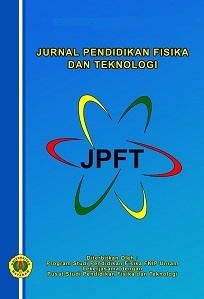Pengembangan Modul Praktikum Osiloskop Untuk Meningkatkan Pemahaman Konsep Arus Bolak-Balik Mahasiswa Politeknik Negeri Bandung
DOI:
10.29303/jpft.v5i1.1159Published:
2019-05-31Issue:
Vol. 5 No. 1 (2019): Januari - JuniKeywords:
Oscilloscope, Alternating Current, Concept UnderstandingArticles
Downloads
How to Cite
Downloads
Metrics
Abstract
The usefulness of the concept of alternating current is very functional for polytechnic students because it provides a basic theory of the production and use of electrical energy. At the Bandung Polytechnic Physics Laboratory, the oscilloscope practicum does not seem to have comprehensively verified the concept of alternating current. Understanding the concept of alternating current has become an urgent need and an indicator of the success of the learning process of Physics for graduates of DIII and DIV of several Bandung State Polytechnic study programs. The main objective of the research is to produce an oscilloscope practicum module that is able to support the learning of the concept of alternating current for Bandung State Polytechnic students through the optimization of the functions of existing equipment and the procurement of new equipment. Through the R & D approach (preliminary study, the design phase, development stage, and validation stage) have produced 2 digital oscilloscope practicum modules, which are assisted by Hantek-DSO-2090. The test results show: the two modules are able to verify the concept of alternating current; practicum with modules has a significant effect on increasing understanding of the concept of alternating current students; practicum module received positive responses from almost all students; and working on practicum modules is felt easy by students even though the material is considered difficult.References
Anderson, L.W. 2001. A Taxonomy for Learning, Teaching, and Assessing: A Revision of Bloomââ¬â¢s Taxonomy of Educational Objectives. New York: Addison Wesley Longman Inc.
Borg, W. R., Gall, M. D., & Gall, J. P. 1979. Educational Research an Introduction. Fifth Edition. New York: Longman.
Dastoori, K. dan Makin, B. 2001. Adhesion Measurements for Electrostatic Powder Coatings Using Drop Test Rig and Virtual Oscilloscope. Journal of Electrostatics, 51-52, 509-514.
Firdaus, M. 2014. Visualisasi Prinsip Kerja Osiloskop Melalui Buku Elektronik Interaktif. Skripsi S1, UPI Bandung.
Hickman, I. 2001. Oscilloscope, How to Use Them, How They Work, Fifth Edition. Amsterdam: Newes.
Nugroho, Murni. T. 2004. Pembuatan Tes Diagnostik Fisika Pokok Bahasan Listrik Statis. Skripsi. Tidak diterbitkan.
Nurqomariah, N., Gunawan, & Sutrio. 2015. Pengaruh Model Problem Based Learning dengan Metode Eksperimen Terhadap Hasil Belajar IPA Fisika Siswa Kelas VII SMP Negeri 19 Mataram Tahun Pelajaran 2014/2015. Jurnal Pendidikan Fisika dan Teknologi, 1(3), 173-179.
Oktaviani, W., Gunawan, & Sutrio. 2017. Pengembangan Bahan Ajar Fisika Kontekstual Untuk Meningkatkan Penguasaan Konsep Siswa. Jurnal Pendidikan Fisika dan Teknologi, 3(1), 1-7.
Rana, K. P. S., Singh, R., & Sayann, K. S. (2010). Correlation based novel technique for real time oscilloscope triggering for complex waveforms. Measurement, 43(3), 299-311.
Serway, A.R. & Cuille, C. 2018. College Physics, Eleventh Edition, Cengage Learning 20 Channel Center Street Boston, MA 02210 USA.
Shanti, M. R. S., Oktaviara, A., Sutresno, A., & Wibowo, N. A. (2014). Pembuatan media pembelajaran pengukuran viskositas dengan menggunakan viskometer dua kumparan dan freewave3. Jurnal Pendidikan Fisika Indonesia, 10(1). 28-35.
Suryadi, 2014. Probe Untuk Oscilloscope Portable Berbasis Laptop. Tugas Akhir DIV, Politeknik Negeri Batam.
Sutrio, S., Gunawan, G., Harjono, A., & Sahidu, H. (2018). Pengembangan Bahan Ajar Fisika Eksperimen Berbasis Proyek Untuk Meningkatkan Keterampilan Berpikir Kritis Calon Guru Fisika. Jurnal Pendidikan Fisika dan Teknologi, 4(1), 131-140.
Young, H.D. & Freedman, R.A. 2016. University Physics with Modern Physics. 14th Edition. Pearson Education, Inc.
Author Biography
I Gede Rasagama, Politeknik Negeri Bandung
License
Authors who publish with Jurnal Pendidikan Fisika dan Teknologi (JPFT) agree to the following terms:
- Authors retain copyright and grant the journal right of first publication with the work simultaneously licensed under a Creative Commons Attribution License 4.0 International License (CC-BY-SA License). This license allows authors to use all articles, data sets, graphics, and appendices in data mining applications, search engines, web sites, blogs, and other platforms by providing an appropriate reference. The journal allows the author(s) to hold the copyright without restrictions and will retain publishing rights without restrictions.
- Authors are able to enter into separate, additional contractual arrangements for the non-exclusive distribution of the journal's published version of the work (e.g., post it to an institutional repository or publish it in a book), with an acknowledgement of its initial publication in Jurnal Pendidikan Fisika dan Teknologi (JPFT).
- Authors are permitted and encouraged to post their work online (e.g., in institutional repositories or on their website) prior to and during the submission process, as it can lead to productive exchanges, as well as earlier and greater citation of published work (See The Effect of Open Access).











